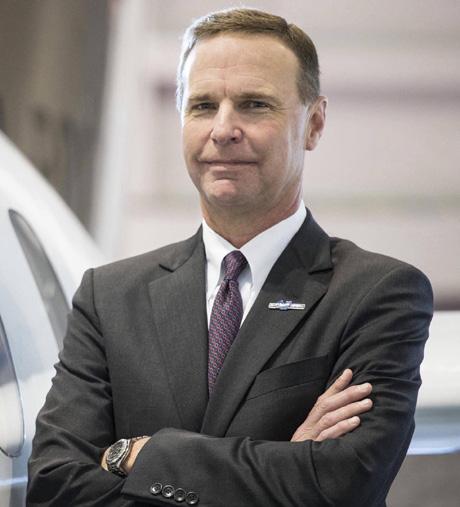
Ed Bolen on NBAA’s Mission and the Military Connect Initiative

Fondy


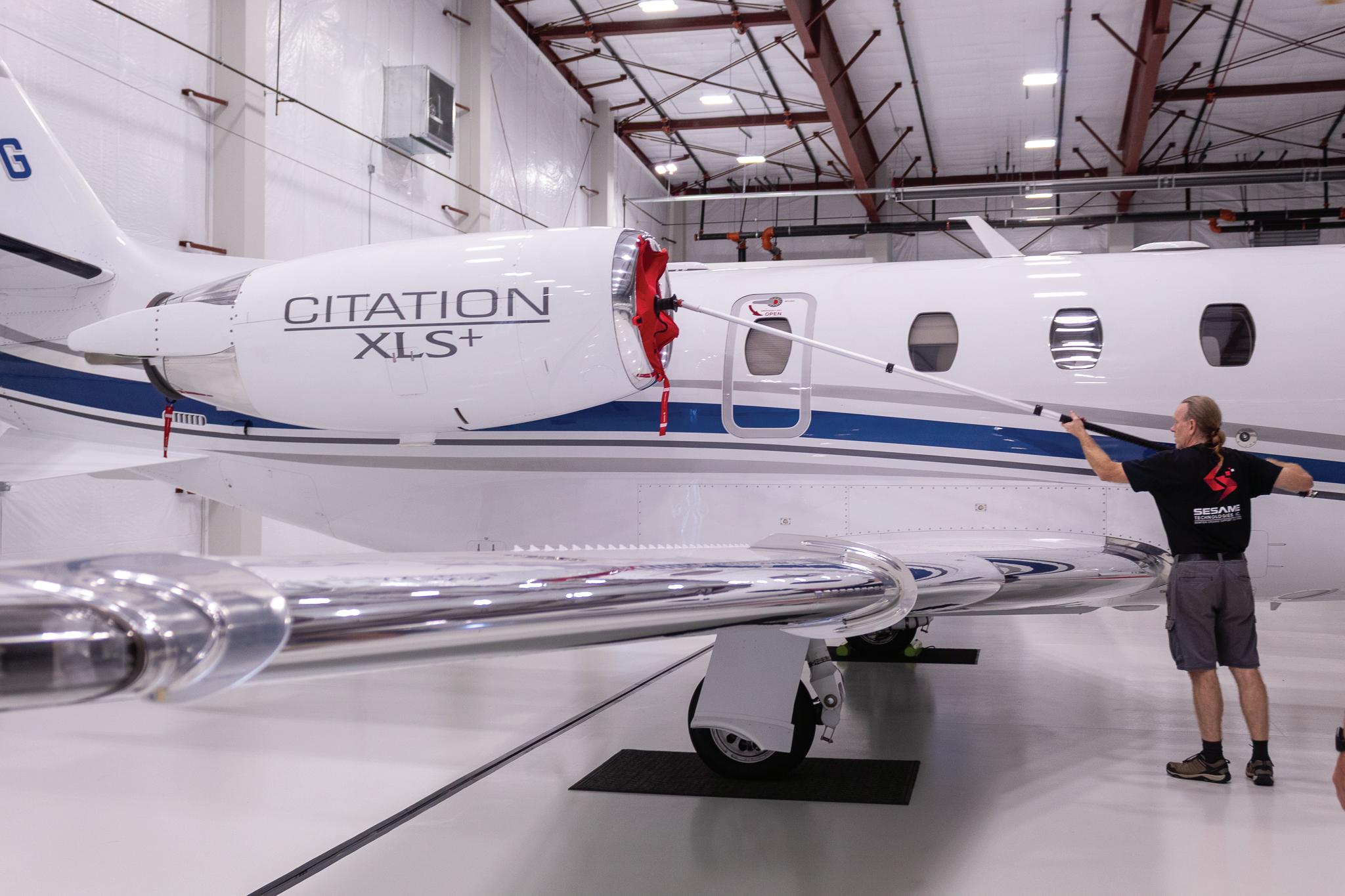







Ed Bolen on NBAA’s Mission and the Military Connect Initiative

Fondy








Dear Readers,
It is a pleasure to welcome you to our Fall 2025 issue of BizAvJets USAMagazine. This edition is sure to bring you some entertaining stories, interesting interviews, and updates in the latest innovations in business aviation. Our recent travels to NBAABACEhave brought us great excitement for this growing industry.
For this quarter, we are excited to bring you a unique blend of stories that are sure to bring you new ideas for your travels and uses of business aviation.
•First up is Jon Fondy of the Las Vegas Television Network. His interactions with business jets for his entertainment mission and vision is inspiring.
•Next, it was our great pleasure to sit down with Ed Bolen of NBAAas he talked about his leadership in the world’s business aviation organization and their connection to the military
• Then, we bring you an oldie but a goodie!Airport Shoppe/Aviation Oxygen is a 40-year-old business holding strong in Silicon Valley. Learn all about the best in oxygen technologies for your private jet!
• Also, a great conversation with Aviation Marketing Power Couple John and Paula Williams of ABCI.
As in quarters past, it is a pleasure to serve you, our readers. We would also like to extend our gratitude to our valued advertisers who support makes this publication possible. Whether you’re a pilot, owner, executive, or enthusiast, we are here to serve as your trusted resource and companion in the skies and on the ground.
Stay safe, fly often, and enjoy the read.
The BizAvJets USAMagazine Team
P.O. Box 5402, San Mateo, CA 94402 (650)358-9908, Fax (650) 358-9254

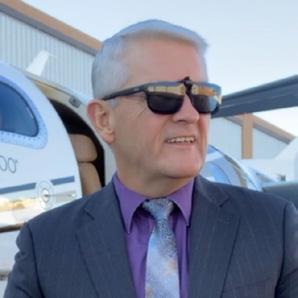



Business matters, advertising and editorial concerns should be addressed to In Flight USA, P.O. Box 5402, San Mateo, CA 94402 or by calling (650) 358-9908–fax (650) 358-9254. Copyright © 2008-2021 In Flight Publishing.
BizAvJets USA is not responsible for any action taken by any person as a result of reading any part of any issue. The pieces are written for information, entertainment and suggestion – not recommendation. The pursuit of fight or any action refected by this publication is the responsibility of the individual and not of this publication, its staff or contributors. Opinions expressed are those of the individual author, and not necessarily those of BizAvJets USA
All editorial and advertising matter in this edition is copyrighted. Reproduction in any way is strictly prohibited without written permission of the publisher.
BizAvJets USA is not liable or in any way responsible for the condition or airworthiness of any aircraft advertised for sale in any edition. By law the airworthiness of any aircraft sold is the responsibility of the seller and buyer.

Interview By Eli Stepp, BizAvJets USA Magazine Co-Publisher
When you sit down with Jon Fondy, the energy is unmistakable. He’s not just a television executive; he’s a storyteller, a producer, and a visionary who has spent decades shaping how people see Las Vegas. As the founder of The Las Vegas Television Network (LVTN), Fondy has built something rare: a media platform that is both local in roots and global in reach.
I’ve known Jon for a while now. We’ve worked together, collaborated, and I’ve even had the chance to learn firsthand about filming through his mentorship. So, when I asked him to share his journey with BizAvJets USA readers, the conversation felt more like a story unfolding than an interview.
Jon’s path into television wasn’t the traditional theater-kid-to-Hollywood pipeline. He began as a business major, but in his mid-twenties he realized the corporate world wasn’t going to feed his soul.
“I wanted something I could do into my 80s, something different every single day, something fun and challenging,” he told me. So, scarf around his neck, sunglasses on, he drove straight into Hollywood declaring, “Here I am.”
Hollywood didn’t exactly roll out the red carpet. Instead, he started at the bottom, learning every facet of
the business including acting, producing, directing, and broadcasting. That education became the backbone of a decades-long career. And when someone once said, “If you think you can do it better, why don’t you?” Jon took that seriously. He did it.
After two decades in Hollywood, Jon made his way to Las Vegas. The city was booming, and he launched a boutique PR and marketing firm while also working as a local newscaster. Before long, he was producing Las Vegas–themed shows for international clients.
One day, with hours of content already in hand, he thought, why not create a network? And so The Las Vegas Television Network was born with the tagline “It’s All Vegas, all the time.”
The audience wasn’t just local. In fact, Jon quickly learned that the world outside Las Vegas was even more fascinated with the city’s energy. After a streaming test, analytics revealed that over 115,000 viewers in 19 countries tuned in without any promotion. That was the proof: Las Vegas was global.
Today, viewers from 163 countries can click onlyvegastv.com and watch the live stream. LVTN has
Continued from Page 4
built a catalog of thousands of hours of original content including reality shows, entertainment, talk programs, celebrity features, even game shows, all centered around the heartbeat of Las Vegas.
As an aviation professional myself, I couldn’t help but steer the conversation toward private aviation. Jon lit up.
“Private aviation has really skyrocketed here,” he explained. “It’s made it easier to get celebrities and production crews in and out. And it expands what’s possible.”
He pointed out something I hadn’t even considered: in Nevada, you can snow ski in the morning and water ski in the afternoon. Remote filming locations that would take hours by car are just minutes away by private jet. For Hollywood-caliber productions, that flexibility is gold.
It’s another reminder of how aviation, entertainment, and business all intersect in Las Vegas—and why the city continues to attract the world’s attention.
Jon isn’t shy about embracing new technology. Artificial intelligence, he says, isn’t foreign to television. It’s simply the next evolution of special effects, production efficiency, and creative expansion. Used right, it helps producers deliver a better product, faster and cheaper.
Then there’s the rise of “microdramas” which are short, scripted pieces built for today’s vertical-screen audiences. Fondy revealed that he and his fellow Young and the Restless alumni are developing a Las Vegas–


themed microdrama soap opera, with episodes just 3–5 minutes long. “It’s the new storytelling frontier,” he said, smiling at the thought of TikTok meeting Hollywood.
On a larger scale, LVTN is stepping into a brandnew chapter: a multimillion-dollar studio inside a major Strip property. “It’ll rival Hollywood,” Jon said with pride. “And it’ll be open for tours and community participation.” After more than a decade debt-free, LVTN is now bringing in strategic partners to help fuel this growth.
Advice and a Final Word
When I asked what advice he’d give to aspiring media entrepreneurs, Jon kept it simple: “Stop thinking about it and just do it. Beg someone to let you work for free. Learn the craft. If it’s for you, you’ll know. If not, you can cross it off the list knowing you tried.”
And in true Fondy fashion, he closed with something deeper: “We’ve always been a faith-based organization. I encourage people to put a little more love in their hearts, be the adult in the room, and use technology for good. Love your fellow man and woman, no matter where they live or what language they speak.”
That’s Jon Fondy, Hollywood polish, Las Vegas energy, and a heart for people. And as LVTN expands, he’s inviting the world to see Las Vegas in ways they’ve never imagined.
We are grateful to have Jon Fondy featured on the cover of BizAvJets USA Magazine. His story reminds us that aviation, business, and media don’t just overlap; they elevate each other, especially in a city like Las Vegas.
Interview by Eli Stepp, BizAvJets USA Magazine Co-Publisher
We recently had the chance to catch up with Ed Bolen, President and CEO of the National Business Aviation Association (NBAA). For more than 20 years, Bolen has been a steady voice for business aviation in Washington and around the world. In our conversation, he talked openly about where the industry stands today, the challenges and opportunities that lie ahead, and why NBAA’s new Military Connect program is such an important step in helping veterans find their place in business aviation.
BAJUSA
Mr. Bolen, how would you describe the current state of business aviation in the U.S. and globally?
EB
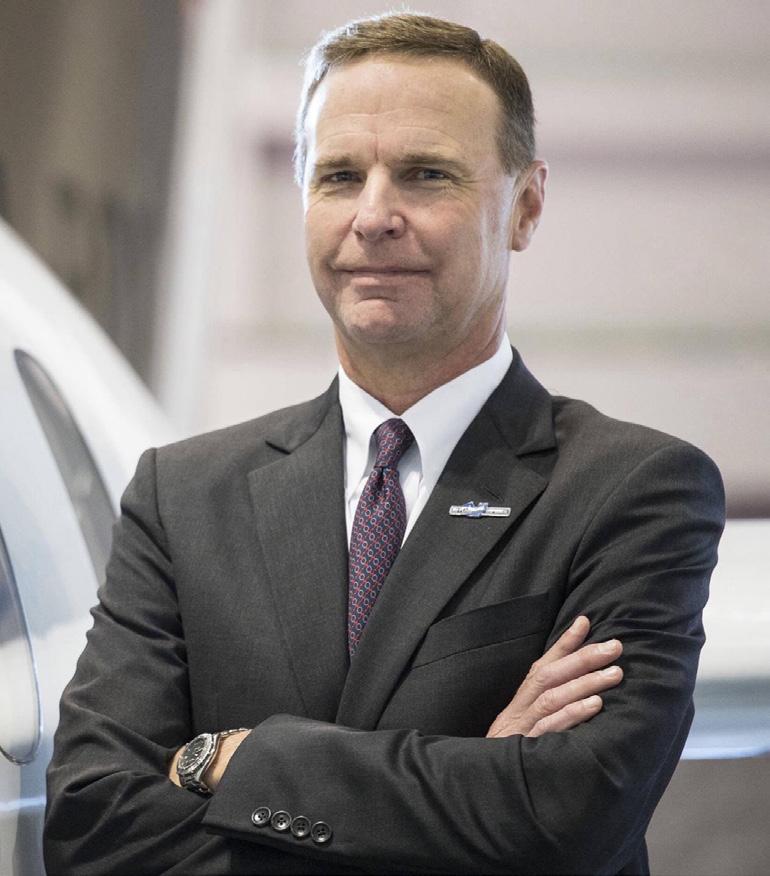
Our industry has largely recovered from the effects of COVID, with most regions having returned to prepandemic levels and a slight uptick in business aviation traffic in North America. At a higher level, we’ve also seen global competitiveness accelerate, with companies and entrepreneurs turning to business aircraft to match this increasing cadence and become ever nimbler in pursuing new opportunities.
The primary drivers affecting our industry remain relatively constant even as economic and political conditions may vary. Business aviation optimizes efficiency, ensures key employees are able to deliver products and services and provides critical transportation alternatives to communities with little or no airline service.
BAJUSA
What are some of the most significant trends or innovations shaping the future of business aviation?
EB
Across the board, business aviation has become ever more accessible to entrepreneurs and companies. That includes the emergence of an increasing number of charter, fractional ownership and jet card alternatives to traditional, sole ownership of business aircraft. We expect to see even
more innovative business aviation use cases, including promising utilization models for the next generation of sustainable aviation technologies and advanced air mobility (AAM) vehicles.
These innovative aircraft will be powered by equally advanced propulsion methods, ranging from sustainable aviation fuel, or SAF –a true game-changer in reduced emissions from today’s turbine business aircraft – to entirely new fuels and into electric, hybrid and even hydrogen propulsion. We’re also seeing new designs, from blended-wing technologies to viable, and quiet, supersonic aircraft, as well as increasing use of unmanned aerial systems (UAS) in business aviation. This truly is a very exciting time to be a part of our industry.
How does NBAA advocate for the industry in Washington and internationally in today’s regulatory environment?
EB
Our industry is an essential, diverse and complex one, which requires a forceful and effective champion for policies that foster the industry’s growth in the U.S and around the world. NBAA was founded more than 75 years ago to serve as a forceful and effective champion for policies that foster business aviation’s growth in the U.S., across North America and around the globe.
In the U.S., NBAA personnel are constantly engaged with our elected representatives on Capitol Hill and the regulatory agencies. We are often invited to provide testimony in Congress on matters affecting the industry, from regulation and workforce to operational safety and taxation. Our team of Regional Directors works with local and state leaders, as well as regional business aviation groups, to foster greater understanding of the industry’s many benefits. In the global arena, NBAAcoordinates
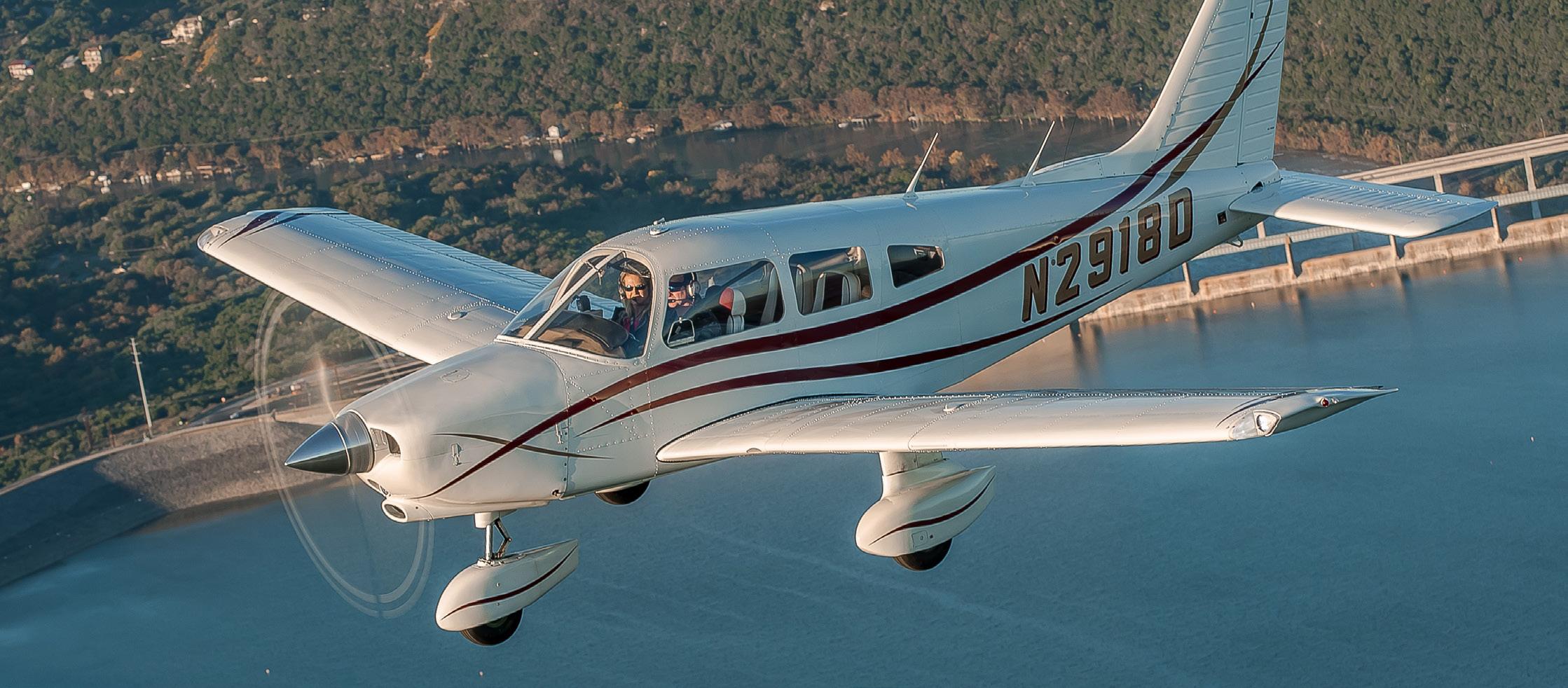
Interview by Eli Stepp, BizAvJets USA Magazine Co-Publisher
When Phoebe Peasley stepped into the aviation retail world alongside her soon-to-be husband Bob Walls in the early 1980s, she had no idea the journey would eventually earn her a global nickname:The Oxygen Lady®. What began as a small retail shoppe has grown into a worldwide leader in aviation oxygen equipment maintenance, serving business jet operators, airline crews and commercial/civilian aviation pilots in more than 100 countries.
Their first store, Pleasure Flying Aviation, opened in a small office-front adjacent to San Jose International Airport in the early 1980’s. It did not take long for the business to outgrow both its space and its name. They rebranded as The Airport Shoppe when they moved into a well-situated larger space in the terminal building at Reid-Hillview Airport in San Jose CA (where their Piper Dakota was hangared.).
The Airport Shoppe at RHV quickly became the go-to destination for aircraft owners/operators, A&Ps, AMTs and IAs who came from far and near (via car or aircraft) for maintenance essentials i.e tires, oil filters, batteries, spark plugs, brake pads, hardware, oil, polishes
and paints etc.
In those early RHV days, Phoebe was approached by Tom Armeo of AEROX Aviation Oxygen to distribute their portable oxygen systems designed for aircraft with service ceilings at or below FL180. With the addition of their excellent line of oxygen equipment, RHV quickly became the trusted hub for low-altitude aircraft oxygen systems which were always in stock. This product line set the shoppe apart from others.
Due to demand from customers, the business gradually expanded into pilot and student pilot supplies i.e. headsets, flight bags, sunglasses, aircraft operating manuals, checklists, FAA test preps, aviator shirts/ties/ epaulets etc - along with VFR and IFR charts covering the U.S., Canada, and Mexico. By 1989, the couple was running four successful retail locations, all at active training fields, serving thousands of pilots, many of whom would go on to professional flying careers.
With the internet’s reshaping of retail in the late 1990, Phoebe had already adjusted course. Two of the
Continued from Page 7
retail stores had been closed, while the Palo Alto and Reid-Hillview locations survived the transition. By 2004, Phoebe had purchased full ownership of the retail business and of the Piper Dakota, steering the company toward specialization.
Since all pressurized aircraft have factory-installed high-altitude, high-pressure oxygen systems, masks and tanks, (manufactured by giants Safran Aerospace and Collins Aerospace) Aviation Oxygen Etc was founded to service this industry.
The focus became the maintenance and/or replacement of flight crew oxygen equipment.
And Most Importantly: Since crew oxygen masks and tanks are not used except during inflight depressurization emergencies, the maintenance of these components is tied directly to life support.
The crew mask requirements:
• Aircraft with service ceilings below FL250 require that all souls will use what are called Rebreather masks or Oxysaver cannulas.
• For those with service ceilings above FL250 thru FL400, the flight crew must use Diluter Demand Masks.
• Above FL400, they must have on board Pressure Demand masks. All diluter and pressure demand masks require overhaul/recertification every six years.
Oxygen cylinder assembly requirements:
• 3AA steel tanks have an unlimited service life; hydro required every five years.
• 3HT steel tanks have a 25 year service life; hydro required every 3 years.
• Kevlar/composite tanks have a 15 year service life; hydro required every 5 years.
• If a hydro shop is NOT DOT approved, a tank should be sent to an FAA approved service station for separation and hydro service.
• Depending on the aircraft assembly CMM the oxygen regulator will need inspection or testing at the time of hydrotest - or at changeout of any expired tank.
• Those regulator assemblies which include an altitude



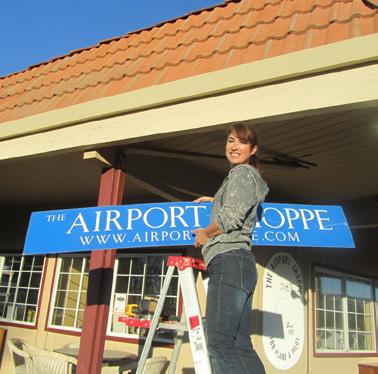
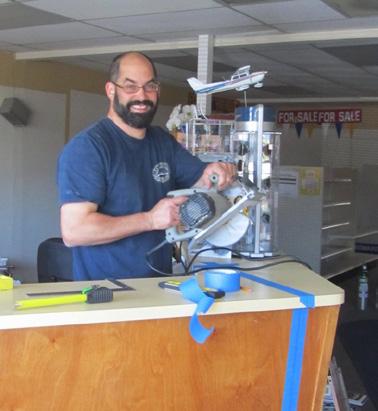
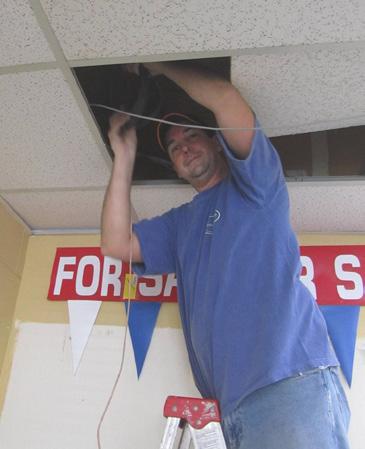
AND THEN COMES MARILU—MY STORE MANAGER (AND BOTH MY RIGHT AND LEFT HANDS).
SINCE MAY 1997
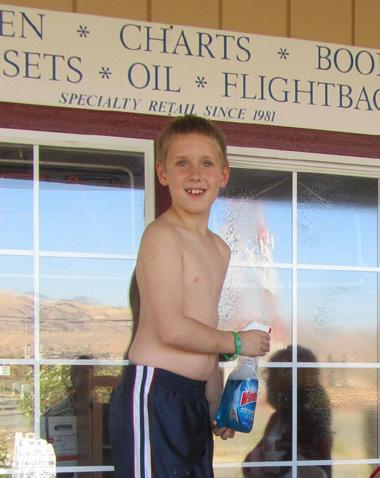

Aviation Oxygen Family Affair” (Photo courtesy of Phoebe Peasley)
compensating unit (ACU) require a functional test at regulator overhaul.
By 2008, online sales dominated revenues, and in 2011, Phoebe trademarked the name The Oxygen Lady®. Her name “Phoebe” was difficult to spell or pronounce for many customers, but The Oxygen Lady® was easy -and fun. Phoebe now works from her office in Los Gatos managing most international sales and servicewith Marilu managing the compact retail shoppe which is now in the RHV AeroTrends Building (also sharing sales & service with Phoebe.) Both businesses remain Sole Proprietorships.
BizAvJets USA Q&A with The Oxygen Lady® BizAvJets USA
Magazine (BAJUSA) You have a great story! We see you have earned the nickname “The Oxygen Lady®.” How did that come about, and what does it mean to you?
Phoebe “The Oxygen Lady®” (AOE)
The name actually came from customers! Pilots would call and say, “I need to talk to the Oxygen Lady,”
Continued on Page 9
Continued from Page 8
and eventually it stuck. For me, it represents trust and familiarity. When people call Aviation Oxygen, they know they’re talking to someone who understands their needs and will make sure they get the life-support equipment they need. (The actual incentive for filing for the trademarked moniker came from a dear friend John Gaetano.)
BAJUSA Aviation Oxygen supports both portable and built-in oxygen assemblies. What sets your offerings apart from competitors?
AOE Since downtime is also a bad word in this industry, we provide inventory, quick service and options. The oxygen tanks requiring replacement (limited service life) are always available for recertification of our customers oxygen cylinder assemblies. We provide options for exchange or outright purchase or service for your existing oxygen assembly, or crew oxygen mask. In cases where crew masks are outdated or superseded or unavailable or unrepairable, options for upgrade or replacement are also provided.
BAJUSA With safety being paramount to speed, how do you ensure fast turnaround while maintaining strict quality control?
AOE Every aircraft cylinder assembly or crew mask is inspected, tested, and 8130-3 recertified (EASA/ UK recerts too) as per the OEM maintenance manual (CMM). Over the years we have built processes and relationships that allow us to move equipment quickly, correctly and affordably - whether for purchase or for maintenance.
BAJUSA How has the demand for oxygen equipment maintenance and replacement/upgrade evolved among business and commercial jets?
AOE High altitude high pressure oxygen systems have long been installed in all aircraft with service ceilings above FL 250. The demand for quick and reliable maintenance and/or replacement of crew oxygen masks & cylinder assemblies increases as the world gets smaller due to the internet & Starlink. The crew mask and the oxygen tank (whether portable or built in) must provide enough oxygen to allow the pilots to descend quickly to altitudes where oxygen is no longer necessary for life support.
NOTE: Since High altitude aircraft manufactured BEFORE the mid 80s were allowed to use Rebreather type masks for crew up to FL300 or F310 (instead of today’s FL250), a large number of our upgrading/
replacement orders come from those fleet owner / operators who have been redtagged by their country’s aviation authority or, can no longer buy or repair/ recertify their outdated equipment. Countries are also gradually requiring/recommending smoke-venting crew masks which means all non-smoke-venting masks will be obsolete.
BAJUSA Looking ahead, what innovations or trends in aviation oxygen technology excite you most?
AOE: Onboard oxygen-generating systems, and generic high-altitude crew oxygen mask production to control costs for STC and factory installations. I helped in the design of one by SAFRAN/EROS which may soon be available for US pilots with FAA certifications. (They are currently only available with EASA certifications.) Also, safety-smoke-venting crew masks as already required by Canada.
BAJUSA Running a specialized aviation business for over four decades is impressive. What has been your proudest milestone so far?
AOE. Beyond this business remaining my life’s passion, it is each time another owner/operator in this fabulous male-dominated industry lets me know that they have been told The Oxygen Lady is the one to call when you have crew mask or tank purchase or maintenance issues. Each mention is a new milestone for me.
BAJUSA Finally, when people think of Aviation Oxygen and “The Oxygen Lady®,” what lasting impression do you hope to leave on the industry?
AOE. If pilots/owner/operators/MROs think of Aviation Oxygen as the company that always has their back, then our efforts have been successful..
As Aviation Oxygen approaches its 50th year at ReidHillview Airport, Phoebe and her team continue to adapt while staying true to their core mission: keeping flight and cargo crews safe, no matter how high they fly. The Airport Shoppe at RHV continues its retail trade, while Aviation Oxygen Etc. continues to expand its global reach now serving owner/operators in more than 100 countries. If you ask Phoebe, the real strengths for her growth & expansion come from a great reputation and many solid business relationships. And that, perhaps, is why the industry knows her best as The Oxygen Lady®.
Editor’s Note:
This article and interview are dedicated to Phoebe Peasley’s beloved son, Brian Peasley, and to her former partner, Robert Walls, both of whom we sadly lost in the spring of 2024, just three weeks apart. Their presence, love, and influence are woven into this story, which would not exist without them.


Barbara Hazelden
In the consistently growing aviation industry, hopping onto a commercial flight is nearly as common as driving a personal vehicle across town. Today, large jets and commuter aircraft serve numerous markets across the United States. In addition, business jets regularly transport company executives between corporate headquarters, regional offices, and key client locations.
Credible experts continue to state that air travel remains a very safe mode of transport. However, several early-2025 fatal accidents may have caused safety experts and aviation analysts to reconsider their opinions. The late-January 2025 collision between an American Airlines jet and an Army helicopter was the year’s first high-profile fatal accident. A Philadelphia metro area medical jet crash occurred two days later, followed by a regional commuter airline crash in Alaska.
Although aircraft maintenance problems haven’t yet been linked to these events, non-compliance with maintenance and safety regulations has contributed to other aviation incidents. This notable connection brings a focus on the dynamics of aircraft maintenance and the aviation maintenance technicians who perform these often-complex services. Today, a nationwide technician shortage has drawn the attention of aircraft maintenance facilities and safety experts alike. A closer look at the shortfall’s scope and causes, and the emerging solutions, puts the issue into focus.
Newer commercial and cargo aircraft typically integrate increasingly sophisticated technology. These airplanes comprise an ever-growing portion of the United States aircraft fleet. For perspective, in 10 years aircraft produced after 2000 will make up over half of the planes in the air. Aviation maintenance technicians must possess the skill sets to adequately service these complex aircraft. Technicians will be expected to apply technology-heavy diagnostic and repair protocols on diverse airplanes.
Concurrently, airplanes that have been flying for decades also need to be serviced. These aircraft have likely experienced age-related “wear and tear” issues. Some older aircraft may also be out of compliance with
mandatory maintenance and/or upgrade regulations. From a technician’s perspective, maintaining both newer and older aircraft requires some overlapping skills. That said, aviation maintenance technicians are expected to possess the distinctive skill sets required to service both aircraft groups.
Keeping countless commercial and cargo aircraft flying is no small feat. Every day, a nationwide workforce of aviation maintenance technicians collectively strives to ensure that airplanes under their purview are safe and airworthy. Working in airline maintenance departments and independent maintenance facilities, these highly trained technicians inspect, maintain, and repair aircraft ranging from smaller turbo-props to sleek-looking commercial jets and mammoth cargo planes.
These talented technicians install systems and equipment, execute tests to ensure proper operation, and perform as-needed adjustments and repairs. In today’s high-technology environment, technicians are increasingly expected to be conversant with the latest electrical systems and avionics. Composite fabrication and repair skills are also highly valued. Finally, technicians should be well versed with predictive maintenance and advanced analytics functions.
Aviation maintenance technicians servicing these high-dollar aircraft must complete extensive training. Some technicians performed a similar role during their time in the military. Other workers obtained an associate’s degree while some younger men and women entered the field directly after high school.
Every aviation maintenance technician has two potential paths to their ultimate goal: the Federal Aviation Administration-issued Airframe and Powerplant (A&P) Certificate. To qualify for this coveted credential, the technician could first complete an FAA-approved training program. Alternatively, the technician can show documented aviation maintenance work experience.
After the technician meets either requirement, they
Continued from Page 11
must sit for their Airframe and Powerplant Exam. This comprehensive test begins with a written component based on recognized standards and practices. Next, a Designated Mechanic Examiner administers rigorous oral and practical (hands-on) tests. During the practical exam segment, the technician must explain (and demonstrate) how to resolve real-world aircraft maintenance problems. The technician’s practical exam could take place on aircraft ranging from a small private plane to a jet.
After successful test completion, the Federal Aviation Administration issues the technician an A&P Certificate. This valuable document verifies that the aviation maintenance technician is ready to execute the wide range of maintenance tasks they may encounter. The A&P Certificate also serves as the baseline for further career opportunities.
In a perfect world, employers’ needs for aviation maintenance technicians would be exactly equal to the number of available personnel. However, an ongoing global increase in commercial aircraft production is vastly outpacing the supply of technicians available to service those planes. For perspective, global management consulting firm Oliver Wyman issued an early-2025 report on the global aircraft industry’s growth. Recordbreaking passenger counts have signaled a need for additional aircraft to carry those passengers.
Specifically, Oliver Wyman’s Global Fleet And MRO Market Forecast 2025-2035 illustrates robust commercial airliner production growth. By 2035, this respected firm expects a 32% rise in aircraft production. Turboprops and regional jets will see slightly less than 1% growth during the period. Widebody jet production will grow by 1.6% while narrowbody jets will realize a 3.7% production increase.
Taking a narrower focus, the Aviation Technician Education Council (ATEC) issued its 2024 Pipeline Report. Sponsored by Oliver Wyman, the Report noted that the North American aircraft fleet is expected to grow by approximately 20% within the upcoming 10 years.
Just as global aircraft manufacturers are beefing up their fleets, the aviation industry is grappling with a growing number of aviation maintenance technician retirements. United States-based facilities have been hit especially hard, as many technicians will be eligible for retirement within the next decade. This ongoing retirement wave is expected to bring a 9% A&P Mechanic shortage. By 2028, this shortfall is predicted to increase to almost the 20% level.
To make matters worse, ATEC noted that 30% of students who complete an aviation maintenance training program switch to a different industry. Poor pay and lackluster benefits, especially for technicians working with budget airlines, are a major contributing factor to this disturbing trend.
Fortunately, a two-part initiative shows promise for turning the situation around. The United States-based Aviation Institute of Maintenance (AIM) is taking the lead on this nationwide effort. AIM is the country’s biggest educational facility focused on training aircraft mechanics. AIM also works to help its graduates obtain employment.
In a February 2025 AirlineGeeks interview, AIM’s CEO Jason Pfaff acknowledged the challenges aviation maintenance technicians face. He also understands the importance of ongoing support during the facility’s 21-month training program. “Learning aviation maintenance is tough…The job can be tough. Folks are on a tarmac or in a hangar, and there’s a lot to learn. So we really want to support and surround our students with support while they’re in school with us,” Jason Pfaff remarked.
Enter Bill Brown, AIM’s Chief Aviation Officer and a retired aircraft mechanic and industry executive. He stepped into his current role after approaching the AIM Board of Directors with an innovative idea. Brown sought to more thoroughly prepare the institution’s students for the expanding aviation maintenance jobs marketplace.
“I wanted to really set up a process where everything that [the training mechanics] would have to do when they went to either an airline or MRO, [that] we’re practicing that now in our hangars…I call it the standard code of conduct while you’re operating a hangar. People safety, product safety, and then success,” Brown explained.
To create the most effective curriculum, Bill Brown contacted several major airlines, each of which boasts a strong United States market presence. Each carrier employs aviation maintenance technicians who keep the airline’s fleet operational. During numerous candid conversations with airline executives, Brown received
Continued on Page 27
Interview by Eli Stepp, BizAvJets USA Co-Publisher
BizAvJets USA Magazine recently spoke with Paula and John Williams of Aviation Business Consultants International, Inc. We are grateful for their time, and we appreciate their insights. We are happy to share their thoughts with our readers.
Bio
Aviation Business Consultants International, Inc. (ABCI), based in Tooele, Utah, is a premier aviation marketing firm established in 2005. Their core mission is to empower aviation professionals. Ranging from FBOs and aircraft sales to MROs and flight schools, they provide more of their products and services through performance-based, results-driven marketing systems. Their methods replace ineffective marketing “randomness” with strategic, measurable campaigns. ABCI delivers a comprehensive suite of services, including digital marketing, SEO, email campaigns, content creation, and even offline marketing assets like trade show planning and print media. Their consultancy leverages a Marketing Master Lab, fusing expertise with tools like GKIC methodologies, Sandler Sales training, and CRM platforms such as Infusionsoft, ensuring campaigns are both creative and scalable. ABCI Clients report transformative results thanks to ABCI’s disciplined, goal-oriented systems, reaffirming their status as a dependable partner in aviation marketing.
Q&A Session with ABCI
BAJUSA
Eli Stepp of BizAvJets USA Magazine here with Paula and John Williams of Aviation Business Consultants International. It’s great to have you both here. Thank you so much.
ABCI
Glad to be here, Eli. It’s great to see you, as always.
BAJUSA
If I may, could you share a brief history of how you two, as a couple, ended up in the aviation marketing world?
ABCI: We met years ago as consultants in the finance industry. Eventually, I bought an airplane, and Paula wanted to learn to fly so we could do it together. From there, she saw how much aviation needed marketing help. That was the turning point that led us into this industry. One of the local flight schools was doing “radio remotes.” They brought in crowds with hot dogs and
giveaways, signed up discovery flights, clogged their schedules, and ended up with unhappy customers and negative reviews. It was feast or famine. We suggested building a steady inbound system instead—through social media, a website, and a “learn to fly” guide. That gave them consistent, manageable student flow.
BAJUSA
So, to summarize, you left finance, bought an airplane, and Paula got hooked on flying. John, you already had Army aviation experience. Did I get that right?
ABCI
That’s right. I wanted to buy an airplane, and Paula wanted to be a competent co-pilot. Once she started flying, she was hooked and left the finance cubicle world behind.
BAJUSA
What aircraft was it?
ABCI
A 2008 Cessna 172SP with a Garmin G1000, brand new from the factory. I even flew it with the test pilot during checkout. It was so stable I managed to slow-fly it at 30 knots something most people wouldn’t believe.
BAJUSA
Once you both got into aviation, you realized marketing was lacking. Was the flight school your first aviation client?
ABCI
Yes, they were. We had non-aviation clients before, like a novelties company and a radio station. However, once we experienced aviation, we knew this was the underserved niche we wanted to focus on. Aviation has unique sales cycles, small client sets, and a specialized vocabulary.
BAJUSA
I read that ABCI was established in 2005. Is that correct?
ABCI
Around then, yes. The company began earlier with non-aviation work, but within a year or two, we shifted exclusively into aviation.
BAJUSA
Do you still get requests for non-aviation marketing?
ABCI
All the time. But we refer those to other firms. Staying focused on aviation provides the best service to


While commercial airlines can’t access some of the globe’s most secluded corners, The Jet Collection (TJC) is redefining what it means to escape. The luxury aviation company is now offering direct private jet routes to destinations so remote, they are virtually inaccessible by traditional couriers.
From unspoiled islands in the South Pacific to surreal natural wonders off the coast of Yemen, TJC’s routes unlock exotic, invitation-only destinations—without the transfers, the crowds, or the compromises.
“These are places where commercial aviation simply doesn’t go,” says the management team at TJC. “For our clients, travel isn’t just about the destination, it’s
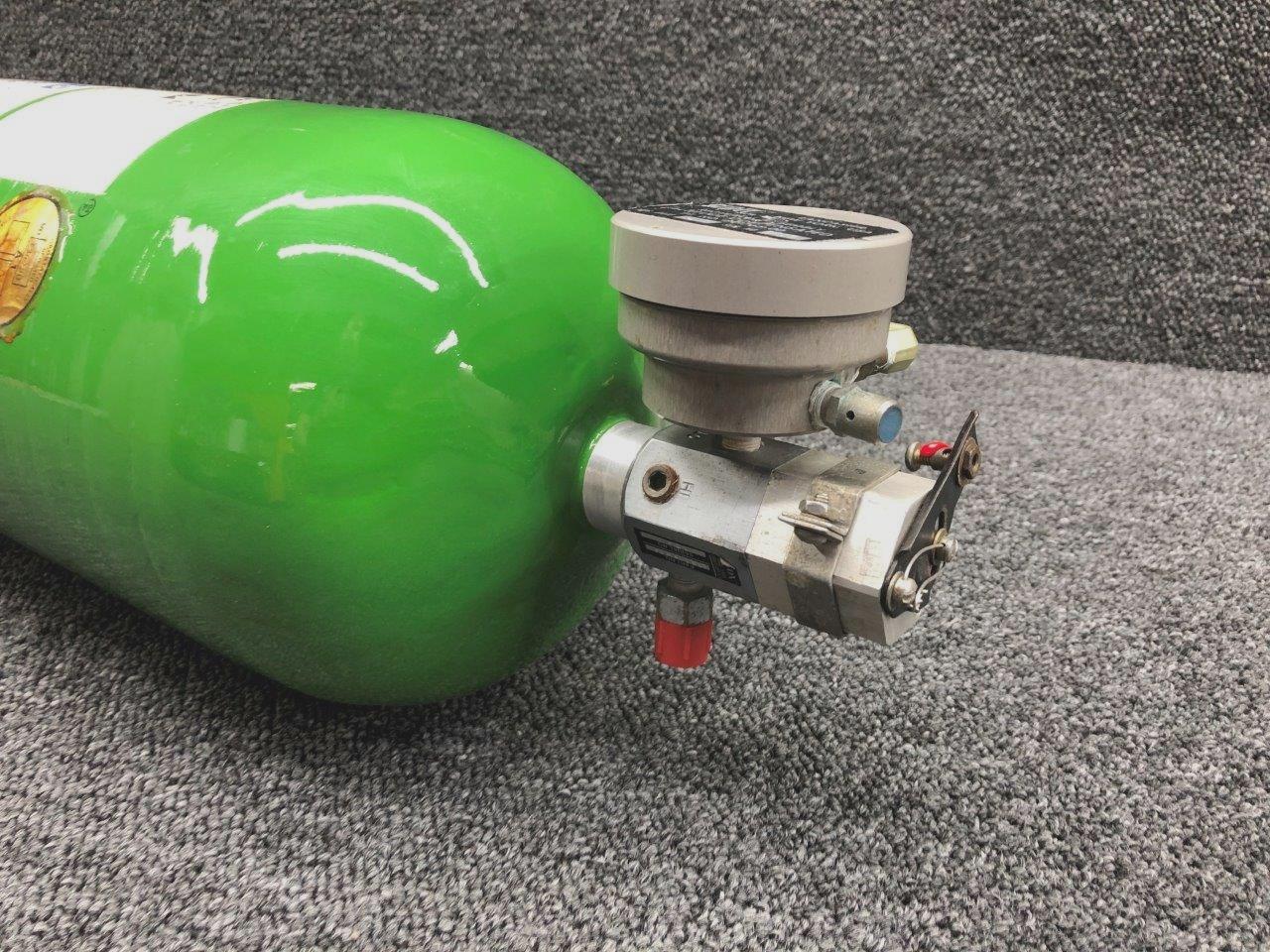
about getting there effortlessly, in comfort, and with complete control over the experience.”
Escape to the Ends of the Earth: Highlights Include Nukutepipi, French Polynesia
A private island sanctuary in the heart of the Pacific, owned by Cirque du Soleil founder Guy Laliberté.
With no commercial access, Nukutepipi is a paradise reserved for a fortunate few.
Route:
• New York
• Tahiti
• Nukutepipi
Continued on Page 21
AIRCRAFT OXYGEN TANKS—REGULATORS—ACUs MAINTAIN/RECERTIFY 8130/EASA/UK

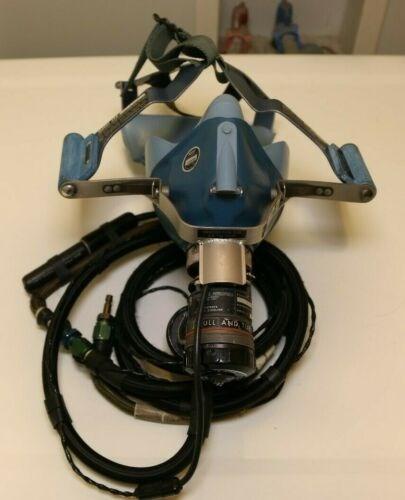



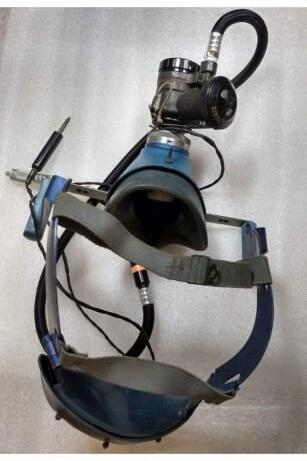

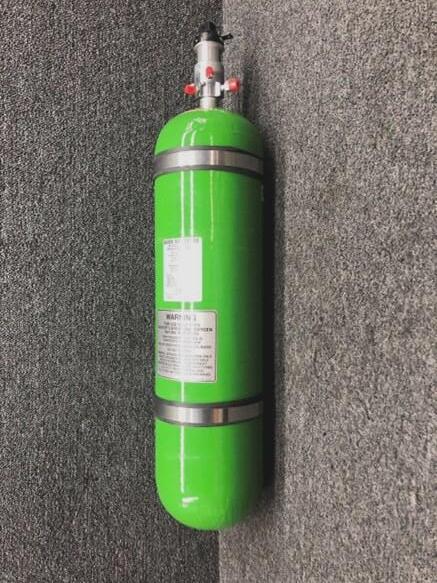
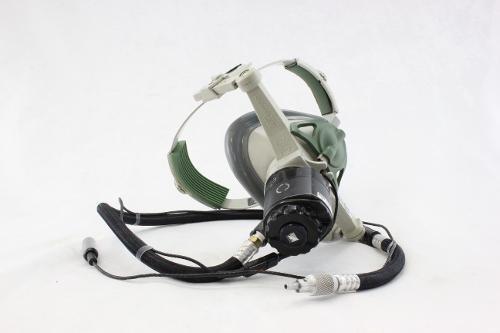


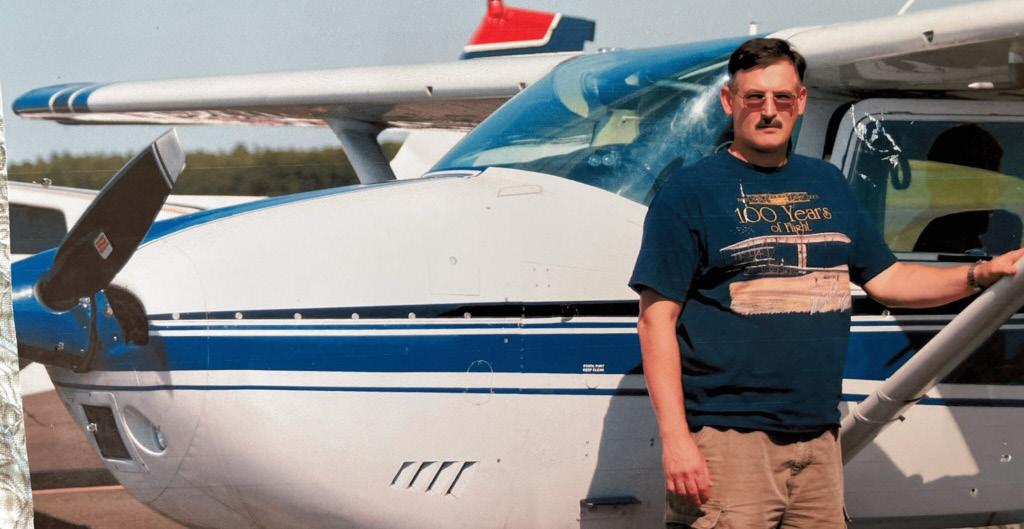
From riding his bike to the airport as a kid to leading IBM’s flight department, Jim reflects on a lifetime in business aviation maintenance.
Interview by Eli Stepp, BizAvJets USA Magazine Co-Publisher
When we think about business aviation, many of us picture the pilots and passengers onboard a corporate jet. But behind every safe flight and every dependable aircraft, there’s a Director of Maintenance making sure everything runs exactly as it should. That role is one of the toughest in aviation. That task of balancing safety, schedules, budgets, and the trust of executives who depend on aircraft availability, is no walk in the park.
Jim Janitis knows that role better than most. As the former Director of Maintenance for IBM’s Flight Department, he’s spent his career at the center of high-level corporate aviation, leading teams, solving problems, and keeping aircraft mission-ready. More than just turning wrenches, Jim has lived the leadership side of mentoring maintenance personnel, embracing new technology, and setting standards others still follow today.
In this conversation with BizAvJets USA Magazine, Jim opens up about his journey, lessons learned along
the way, and his perspective on where business aviation is headed next.
Q&A with Jim Janaitis
BAJUSA
Jim, thanks for joining us.
JJ
My pleasure. It’s good to talk again.
BAJUSA
We are thrilled to share your story with our readers. Let’s start at the beginning. Can you tell me about your journey in aviation, and how that eventually led you to becoming the Director of Maintenance at IBM?
JJ
For me, it was a no-brainer. Ever since I was a kid, I have loved airplanes. My father couldn’t understand why I’d ride my bike to the airport before I even had a
Continued from Page 16
license, just to hang around. I got my pilot’s license in 1971, went on to A&P school at East Coast AeroTech in Lexington, Massachusetts, and I just fell in love with it. I didn’t know if I’d like the mechanical part at first, but I loved it.
BAJUSA
Where did that first A&P job take you?
JJ
Right after school, it was tough as the first fuel embargo was on, and jobs were scarce. I hit every airport in New England looking for work. I finally landed at a flight school in Westfield, Massachusetts, basically pulling panels. Later, I joined a small avionics shop near where I grew up in Central Mass, became the chief inspector, and learned a ton. That foundation in avionics really helped me throughout my career.
BAJUSA
Let’s jump to IBM. As Director of Maintenance, what would you say was your biggest challenge and your biggest reward?
JJ
The challenge is you’re on 24/7, 365. If anything hiccups with the airplanes, you’re the first call. But I was fortunate to have an incredible team of13 technicians, and a full repair station. The reward was leading that team and knowing we could support a large flight department at the highest level. Before IBM, I worked for Canadair (which became Bombardier), and those experiences prepared me well for IBM.
BAJUSA
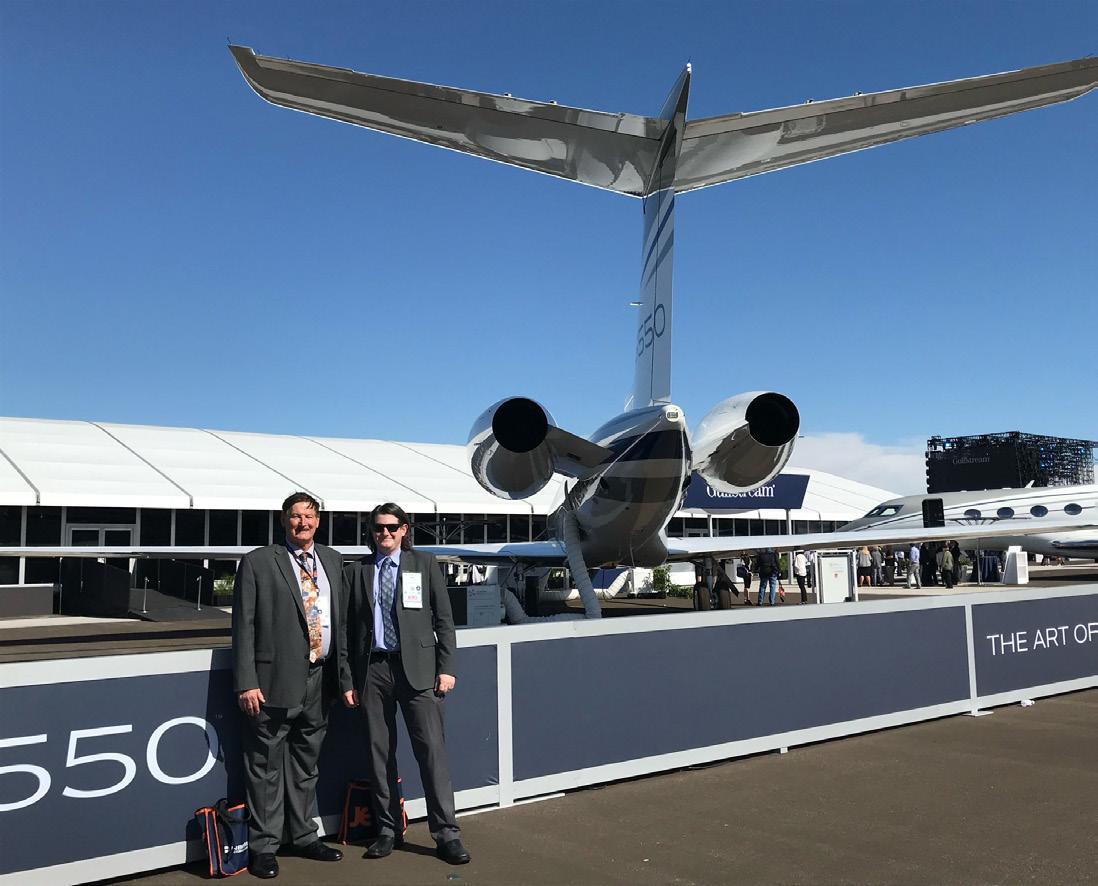
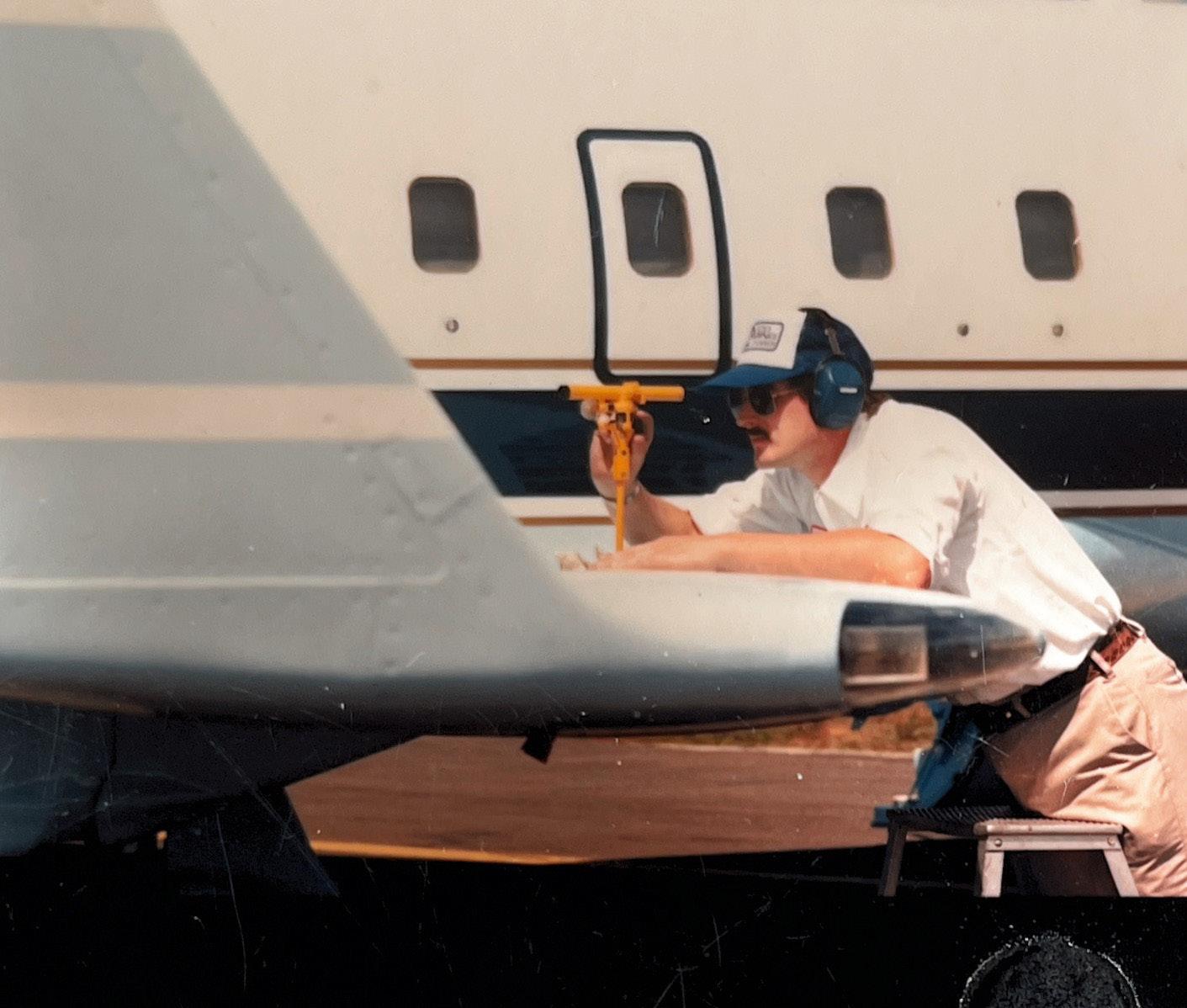
How long were you with IBM?
JJ
Twenty-five years. I’m very fortunate, it was a great run.
BAJUSA
What airplanes did you start with at IBM, and what did you have when you retired?
JJ
When I started, we had just phased out some Gulfstream IIIs, were buying a Gulfstream V, and had three Falcon 2000s on order. We also operated a Falcon 50 and had an S-76 helicopter in the mix.
BAJUSA
How did you balance the daily operational demands with long-term maintenance strategy?
JJ
That’s one of the toughest parts. Day-to-day always comes first as aircraft must be safe and available. But you also have to think long-term: asset management, planning future maintenance, and keeping leadership confident in the department’s efficiency and safety.
BAJUSA
Speaking of teams, how did you go about building and mentoring talent?
JJ
A mix of word-of-mouth and structured programs. I set up an internship program with Embry-Riddle, which brought in some great young talent. We’d also hire temporary help during busy times. It gave us a chance to see how someone fit with the team before bringing them on permanently.
BAJUSA
Let’s talk about technology. How was maintenance
Continued from Page 13
our clients.
BAJUSA
Who are your typical clients, and what services do they seek most often?
ABCI
Most come to us first for help with websites. Then they realize they also need LinkedIn, YouTube, and email strategies. Those are our top areas, but we also do postcards, print, and other collateral.
BAJUSA
Some aviation marketing firms handle booths and trade show production. Do you do that?
ABCI
No, we usually refer that work to partners.
BAJUSA
How many clients do you currently serve?
ABCI
About 30, ranging from our top “Titanium” level down to “Silver.”
BAJUSA
In the spirit of full transparency, BizAvJets USA uses your LinkedIn posting service, and we’re thrilled with it. Do you manage social media for most of your clients?
ABCI
Yes. Since we’re already producing great content for them, it’s easy to extend that to LinkedIn and other platforms.
BAJUSA
Do you also work with Instagram, Facebook, or even TikTok?
ABCI
Yes, though most measurable results come from websites, YouTube, and LinkedIn. TikTok is requested by a few clients, and it’s great for building relationships but it isn’t as strong for sales or actual revenue generation as LinkedIn and YouTube right now.
BAJUSA
What about video production? Do you produce content for clients?
ABCI
We do. We create 4K internet-quality videos, often by editing short “talking head” recordings clients send us. We also provide free studio time for clients who come to Salt Lake City, which is cheaper to fly in than to rent a studio.
BAJUSA
What’s next on your roadmap?

Continued on Page 20

Continued from Page 18
ABCI
Like many companies, we’re incorporating AI into our workflows. We use what we call the “AI sandwich,” basically a human reviews the work before and after AI touches it. We’re also developing an AI agent that will host one of our workshops at next year’s industry breakfast.
BAJUSA
That’s innovative. Beyond AI, you’re also known for your Book Club. How’s that going?
ABCI
Very well. We’ve involved our team more directly, which has enriched discussions and built stronger client relationships. It helps flatten our organization and sparks collaboration. We also encourage clients to talk to each other. Book Clubs and group office hours create connections. Often, our clients end up doing business with one another.
BAJUSA
You also run a podcast. How often do you release episodes?
ABCI
We aim for weekly, though we reliably do at least two per month. Episodes include workshops, book clubs, client interviews, or deep dives into hot topics like AI. Occasionally, we’ll turn a rant about bad marketing into an episode too!
BAJUSA
Do you post those podcasts directly or edit them into social content?
ABCI
We usually keep them intact because the conversations are compelling, but we also create shorts. Our average listen time is 30–40 minutes, which is excellent for aviation podcasts.
BAJUSA
Do you stream them live?
ABCI
Not anymore. Recording and cleaning them up produces a much better final product.
BAJUSA
How do you see the next five years?
ABCI
We maintain one-, five-, 10-, and even 50-year plans. Our near-term goal is 100 clients. In five years, we want to expand our mix toward UAV and high-end clients.
BAJUSA
Do you have onsite employees or a remote team?
ABCI
All remote, except John. Our team spans several
countries, including Pakistan, Nigeria, Mexico, and the Philippines.
BAJUSA
How do you manage hiring?
ABCI
We give prospective contractors a $100 test project. If they deliver, we build more work with them. Many become long-term team members. They’re independent professionals, not employees, but we coordinate through Basecamp.
BAJUSA
Do you still see value in print marketing?
ABCI
Absolutely. Print offers credibility and staying power. We often combine it with QR codes, which bridge print and digital.
BAJUSA
Wonderful. Any closing thoughts?
ABCI
You’ve covered just about everything. Thank you.
BAJUSA
Kudos to you both for building a thriving company together. We appreciate the service we get from ABCI and look forward to expanding our partnership.
ABCI
Thank you.
BizAvJets USA Magazine wishes all the best to everyone at ABCI. For more information regarding their services visit https://aviationbusinessconsultants.com.

Continued from Page 17
when you started compared to when you left?
JJ
Night and day. Early on, troubleshooting meant sticking pins in wires and trying to figure out issues manually. By the time I left, so much could be done from the cockpit or with a laptop. Predictive analytics also grew, though early systems like CAMP were mostly historical record-keeping. Later, tools like event tracking through NBAA committees allowed us to benchmark our fleet against the industry. That was invaluable.
BAJUSA
Today, AI is the buzzword. What’s your take on its role in aviation maintenance?
JJ
I have high hopes. If you can track an aircraft part from birth to retirement, pairing blockchain-type systems with AI. You now have predictive power we never had before. IBM had been working with blockchain for over 15 years, and if applied broadly to aviation, it could
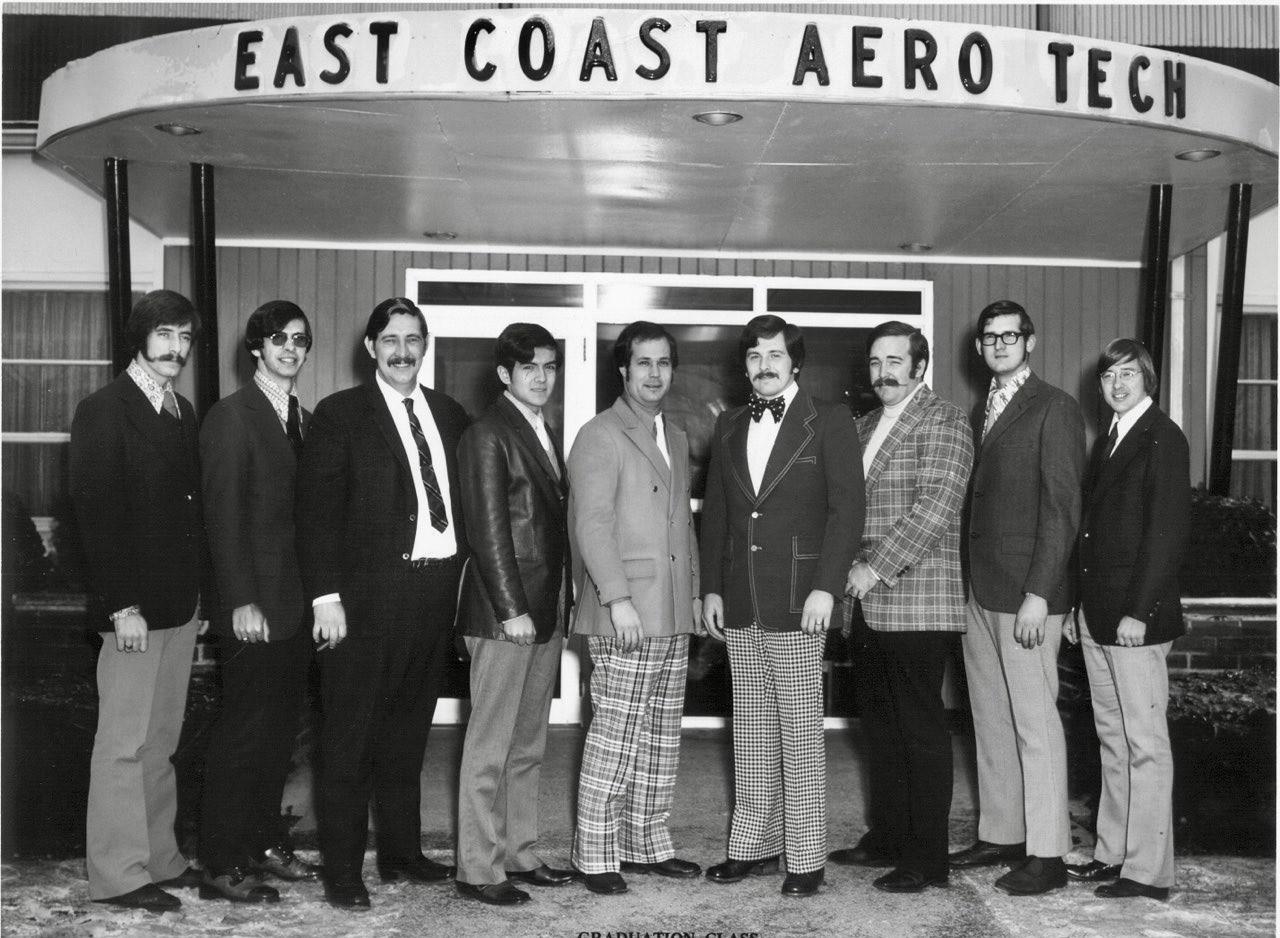
change the game.wapplied across the flight department, from pilots to flight attendants. It required resources, but IBM was committed to investing in safety.
BAJUSA
Whatwouldyousayisyourproudestaccomplishment inbusinessaviation?
Continued on Page 26
Continued from Page 15
• Travel time: Approx. 13–14 hours total
• Aircraft: Ultra-Long Range Jet + Light Jet
• Estimated cost: From €160 000
Socotra, Yemen
Dubbed the “Galápagos of the Indian Ocean,” Socotra is a UNESCO-listed island known for its alienlike dragon blood trees and biodiversity.
Route:
Paris or London
Socotra (non-stop options available)
Travel time: Approx. 7 to 9.5 hours
Aircraft: Executive Airliners or Ultra-Long Range Jets
Estimated cost: Between €80,000 and €100,000 (Paris) or between €90,000 and €110,000 (London); higher depending on jet type and availability Cavallo Island, Corsica
Continued on Page 22

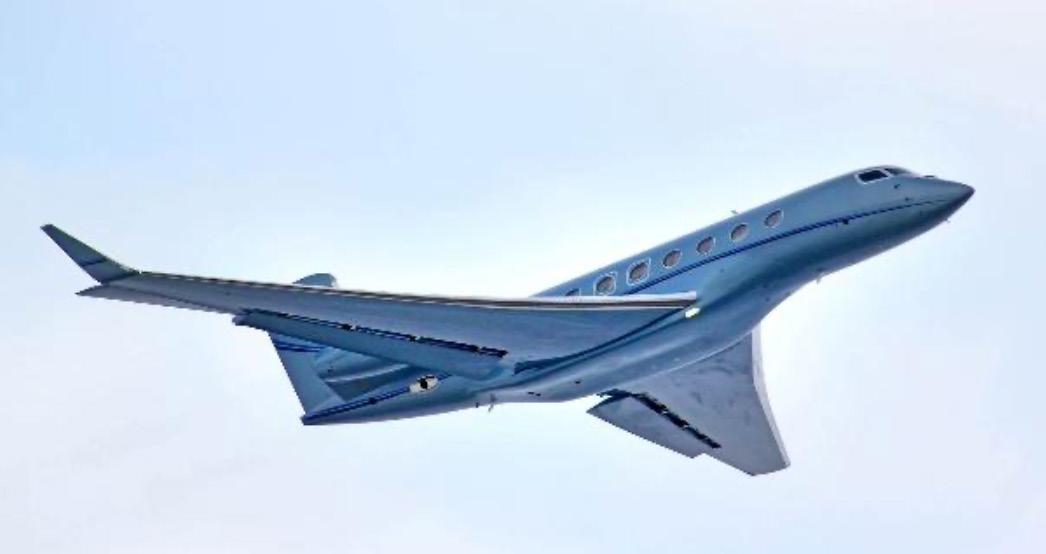
Continued from Page 21
A Mediterranean jewel with no commercial airport, Cavallo is reachable only via helicopter from Figari after a short private helicopter ride, making it a true hideaway.
Route:
• London
• Figari
• Cavallo
• Travel time: 2.5 hours (jet) + 15 minutes (helicopter)
• Estimated cost: Between €12,000 and €35,000 ~€1,500 for the helicopter transfer
Each route is fully bespoke, with aircraft selected to suit distance, comfort, and timing. TJC manages every detail (from departure at a private terminal to final arrival), ensuring a seamless luxury experience. With flight times optimised and stopovers eliminated, remote travel becomes not just possible, but enjoyable.
Continued from Page 6
with our international partners on multiple shared priorities, including through the International Business Aviation Council (IBAC).
BAJUSA
What role do sustainability initiatives play in NBAA’s strategic vision?
EB
As I mentioned earlier, NBAA is at its core an advocacy organization, and that includes promoting advanced technologies to usher in a new era of safety and sustainability. Perhaps our most prominent example of a programmatic effort in that regard is CLIMBING. FAST., an industry advocacy initiative launched two years ago to not only showcase business aviation’s many societal benefits, but to also how our industry is leading sustainability innovation with a goal of achieving net-zero carbon emissions by 2050. This commitment also extends to the Federal Aviation Administration’s (FAA’s) release last year of its Special Federal Aviation Regulation (SFAR) to establish requirements for the safe, efficient integration of AAM aircraft into the nation’s aviation system. Notably, the SFAR was signed at the opening day of the 2024 NBAA Business Aviation
The Jet Collection is a leading private aviation company offering tailored jet services to destinations beyond the reach of commercial travel. Nestled in the heart of the French Riviera, The Jet Collection’s headquarters encapsulates the spirit of luxury and sophistication. With representative offices strategically located in the UK, the US and the hub of Dubai. Each location embodies our commitment to unparalleled service and reflects the unique character of its region.

Convention & Exhibition (NBAA-BACE), highlighting our association’s role in making AAM flights a reality.
In another example of our industry’s impact, the U.S. House of Representatives Appropriations Committee recently advanced critical language, strongly supported by NBAA, in two key Fiscal Year 2026 appropriations bills recognizing the importance of sustainable aviation fuel (SAF) and the role it plays in decarbonizing aviation. That builds on the SAF blender’s tax credit, introduced through the Inflation Reduction Act of 2022, which incentivizes expanded SAF production and availability.
BAJUSA
How is NBAA engaging younger generations and emerging professionals in aviation?
EB
NBAA is addressing workforce challenges in several ways, including through our Collegiate Connect program at NBAA-BACE, to build early awareness among young people about aviation careers. Our YoPro (for “young professionals”) Council helps nurture emerging talent already working in business aviation, while the NBAA Mentorship Network helps build connections between established industry professionals and those building their careers in the industry.
Additionally, NBAA has partnered with the Alpha Eta Rho aviation fraternity organization to collaborate on
Continued
PLANO, TX – July 31, 2025 – Rolland Vincent Associates (RVA), a consultancy focused on business aviation intelligence, strategy, and forecasting, today released a definitive new research report. Entitled Back to the Future: In Support of a Zero-Tariff Marketplace for Business Jets, it is a comprehensive analysis that strongly advocates for a tariff-free marketplace, underscoring the industry’s critical role in U.S. national security and global competitiveness.
RVA’s report directly addresses potential U.S. national security concerns outlined in the Department of Commerce’s Section 232 Investigation, launched May 1, 2025. This investigation examines imports of commercial aircraft, jet engines, and parts—including the vital business aviation sector. In late May 2025, RVA submitted its findings to the Department’s Bureau of Industry and Security (BIS), Office of Strategic Industries and Economic Security in response to their request for stakeholder input.
RVA President Rollie Vincent stated, “We urge policymakers to oppose new tariffs, reaffirm multilateral commitments, and promote data-driven policies that have set the stage for U.S. leadership in civil aircraft development and manufacturing. Business aviation thrives on international collaboration, and a stable, zero-tariff trade environment has fueled decades of investment, innovation, and high-paying jobs in America. The U.S. business jet manufacturing industry consistently generates a significant trade surplus and is a model for other sectors to emulate.”
Dr. Dean Roberts, RVA Vice President, Strategy, Sustainability & Development, added, “Our message to policymakers is clear: don’t disrupt what works. Free and fair trade has helped cement America’s leadership in business aviation. We urge the preservation of conditions - open markets, stable rules, and trusted partnershipsthat have fostered U.S. global leadership. Our report’s data confirms that this trade environment attracts global investment and fortifies the U.S. business aviation industry.”
Main Conclusions from the RVA Research Report include:
• Business Aviation: A Strategically Vital U.S. Industry.
• Sector Defined by Long-Term Investment & Complex Regulations.
• Foreign Investment Enhances U.S. Industrial Strength.
• Policy Focus: Enabling Global Leadership Through Open Markets.
RVA’s new Zero-Tariff report is the first in a series and can be downloaded at: https://rollandvincent.com/ research-reports
Rolland Vincent Associates, LLC (RVA) is a consultancy focused on business aviation intelligence, industry and market research, strategy, and forecasting. RVA’s client base includes the world’s foremost civil aircraft and engine manufacturers, aerospace suppliers, aviation service providers, fleet operators, lenders / lessors, and the investment community.
For more information, please contact: Rollie Vincent President
Rolland Vincent Associates rvincent@rollandvincent.com Tel: 972-439-2069 (U.S. Central Time)
Dean Roberts, Ph.D. Vice President, Strategy, Sustainability & Development
Rolland Vincent Associates droberts@rollandvincent.com
Tel: 1-571-278-7297 (U.S. Eastern Time)
Continued from Page 22
initiatives to support and advance business aviation. That includes advising college students of career opportunities in the industry, and ensuring they have a voice in Washington, DC in shaping their roles in business aviation’s future.
NBAA’s “Military Connect” Initiative
BAJUSA
Can you share the inspiration and objectives behind NBAA’s new “Military Connect” program?
EB
NBAA Military Connect was designed by staff members who previously served our nation’s armed forces, along with NBAA members who served in the military before enjoying successful careers in the aviation industry. These volunteers, in turn, had several insightful conversations with other veterans about how we could better engage with those exiting military service today.
Taking place Oct. 15 at NBAA-BACE in Las Vegas, NV, the Military Connect program will provide essential knowledge and guidance relevant to navigating the civilian aviation landscape. Attendees will have the opportunity to participate in targeted experiences on the NBAA-BACE exhibit floor, including a military meet-up at the NBAA booth for networking, as well as special engagements at the NBAACareer Zone. The day will conclude with a final session to reinforce key takeaways and provide additional support for a successful transition.
BAJUSA
What types of career pathways does Military Connect aim to bridge between military veterans and the business aviation industry?
EB
NBAA takes an expansive view on this, because there really isn’t a single job in our industry for which veterans aren’t well-suited. Military pilots are often eager to transition to flying the latest and most advanced business aircraft, for example; and aircraft maintenance technicians (AMTs) will find their skills equally well-suited to working on piston, turboprop and turbofan aircraft.
That said, personnel with non-technical backgrounds can also find many career opportunities in business aviation, with companies and organizations that value their strong work ethic, leadership skills and ability to handle challenging situations.
BAJUSA
How is NBAA partnering with companies and government agencies to support transitioning service members?
EB
NBAA is collaborating with numerous entities, both within the industry and those in government, oversight and
regulatory roles, to help drive inclusion of military veterans in business aviation. These conversations will also be a big part of NBAA Military Connect in opening doors for anyone transitioning from active military service to a career in the business aviation sector.
BAJUSA
What kinds of roles in business aviation are best suited for veterans coming out of the military?
Again, there are many skills learned in military service that are directly applicable to business aviation, from piloting and maintaining aircraft to scheduling operations and managing people. The sky really is the limit, as it were.
BAJUSA
Are there specific certifications, trainings, or resources that NBAA is helping veterans access?
EB
At this time, our primary focus is to bring military veterans to the table, introduce them to what our industry has to offer and to foster interactions with business aviation companies seeking these highly skilled and qualified workers. Over time, it’s possible this process will result in additional dedicated NBAA initiatives as Military Connect similarly grows and evolves over the next few years.
BAJUSA
How can business aviation companies actively participate or benefit from this initiative?
EB
I strongly encourage any company in business aviation seeking to grow their ranks to participate in Military Connect and meet these veterans who represent a diverse, professional, highly skilled and mission-dedicated workforce.
BAJUSA
Why do you believe veterans are a great fit for the business aviation industry?
EB There is a long history of military aviators and other personnelbringingtheirleadershiptocivil aviation.Not onlydotheybringtheirskillstothe industry,aspreviously noted;theyalsoprovidevaluable direction,commitment anddisciplinetotheircompanies. We’reexcitedtodeepen theserootswithNBAAMilitary Connect,toequipthese patriotsandmilitary professionalswiththeknowledge, connections,and confidencenecessarytoembarkonfulfillingcareersin civilianaviation.
BAJUSA
What advice would you give to a service member preparing to separate from the military and looking into aviation careers?
EB We encourage anyone seeking a career in our industry to utilize social media like LinkedIn to build a network of industry contacts who can help with their job search. They should also track job boards at jobs.nbaa.org, charter companies, MRO's and aircraft Manufacturers.
Continued from Page 24
They can also get involved with their local and regional business aviation groups, and attend industry events like NBAA-BACE. For maintenance professionals specifically, we also recommend earning their FAAA&Pcertificate before separating from the military.
And, of course, check out NBAA Military Connect! This isn’t a matter of a lack of possible career paths in business aviation for veterans, but rather one of awareness. We look forward to introducing them to our industry and its many possibilities for those exiting the armed forces.
BAJUSA
How is NBAA helping to address the growing workforce shortages in aviation maintenance, operations and pilot roles?
EB
In addition to NBAA Military Connect and the other programs I’ve mentioned, NBAA’s member publication Business Aviation Insider recently highlighted a visit by three veterans now working in business aviation with airmen of the 121MXG at Rickenbacker Air National Guard Base in Columbus, OH to discuss the current market for aviation maintenance technicians (AMTs) and to offer guidance in finding their places in our industry. The good news for them is we are not lacking for potential opportunities.
BAJUSA
What success stories have you seen so far from veterans transitioning into business aviation?
EB
I would look to the significant number of former military personnel already working in our industry today, including at NBAA. One of our board members is a four-star general, for example, while others are leading the association’s environmental and technical operations and our safety, security, sustainability and international advocacy efforts. Programs like NBAA Military Connect now help us reach out to the next generation of leaders and professionals.
BAJUSA
You’ve led NBAA since 2004. What has been your proudest moment or achievement during your tenure?
EB
The important thing is to focus on all we’ve realized throughout our industry, the many people whose work has led to the sector’s successes, and the potential of what we have yet to achieve throughout this unique and impactful community.
Business aviation is really about the people who bring both their passion and profession forward, every single day,
to strengthen our industry. It truly illuminates the power and potential that can be achieved when bringing this unique skillset to bear.
BAJUSA
What keeps you passionate about serving the business aviation community?
EB
It really is about our industry’s proud and storied legacy, and how that drives all our potential for the future. We all stand on the shoulders of giants who laid the groundwork for business aviation decades ago, and set the groundwork for successes we can achieve today and tomorrow. Across all domains, I believe we continue to see astonishing leaps forward, realized through continued investment in the future.
BAJUSA
How do you define success for NBAA—and for yourself as its leader—in the coming decade?
EB
NBAA’s mission will remain as it always has been, to foster the growth of business aviation in the United States and around the world by championing legislative and regulatory policies that grow the industry; hosting world-class aviation events, NBAA-BACE; supporting our members in their day-to-day utilization of business aircraft; and promoting initiatives to grow our next generation workforce.
I am confident our industry has a bright and sustainable future ahead, and NBAA will continue our efforts to ensure business aviation grows stronger five, 10 and 50 years down the line.
Final Wrap-Up
BAJUSA
If you could deliver one message to veterans about opportunities in business aviation, what would it be?
EB
This is truly an industry with boundless opportunities for those who’ve served in the military and who believe in being part of something larger than themselves.
BAJUSA
How can readers of BizAvJets USA Magazine get involved with or learn more about NBAA and Military Connect?
EB
Go to the Military Connect resource on our website for NBAA-BACE, at https://nbaa.org/events/2025-nbaabusiness-aviation-convention-exhibition-nbaa-bace/ military-connect-2025-nbaa-bace/. I also encourage them to reach out to individual NBAA staffers who’ve previously served in our armed forces, by calling our organization at (202)783-9000.
BAJUSA
BizAvJets USA Magazine sincerely thanks Mr. Bolen for taking the time to share his insight with us.
Working with the NBAA Maintenance Committee. As chair of the training subcommittee, I helped push forward technical training programs that made a lasting impact, like Gulfstream’s Triple T program. To be part of industry-level improvements was incredibly rewarding.
BAJUSA
If you were starting over today, would you do anything differently?
JJ
I might have pursued an Associates degree earlier. I eventually earned one but getting it upfront could have helped me early in my career.
BAJUSA
Where do you see business aviation maintenance heading in the next 5–10 years?
JJ
AI and predictive systems will play a huge role, but I worry about the trend of outsourcing everything. You lose oversight and that personal connection to your aircraft. I’ve always believed you need your own people on-site when an airplane is in for a major work package.
BAJUSA
What’s your message to today’s business aviation leaders?
JJ
Be honest and use real data. Don’t sugarcoat. Corporate aircraft are tremendous tools, but leadership needs accurate, transparent information.
BAJUSA
And to young professionals entering business aviation maintenance?
JJ
Don’t just focus on the airlines. Corporate aviation offers incredible opportunities, but it’s not talked about enough in schools. We need to introduce students earlier, even at the high school level, to show them that business aviation is a rewarding, viable career.
BAJUSA
Jim, that’s excellent advice. Any final thoughts?
JJ
Just that I feel fortunate every day to have built a career in corporate aviation. It’s given me skills, friendships, and experiences that enriched both my professional and personal life. If you always focus on doing the next right thing, aviation can give you a wonderful career.
BizAvJets USA Magazine wishes Jim the very best in future endeavors.
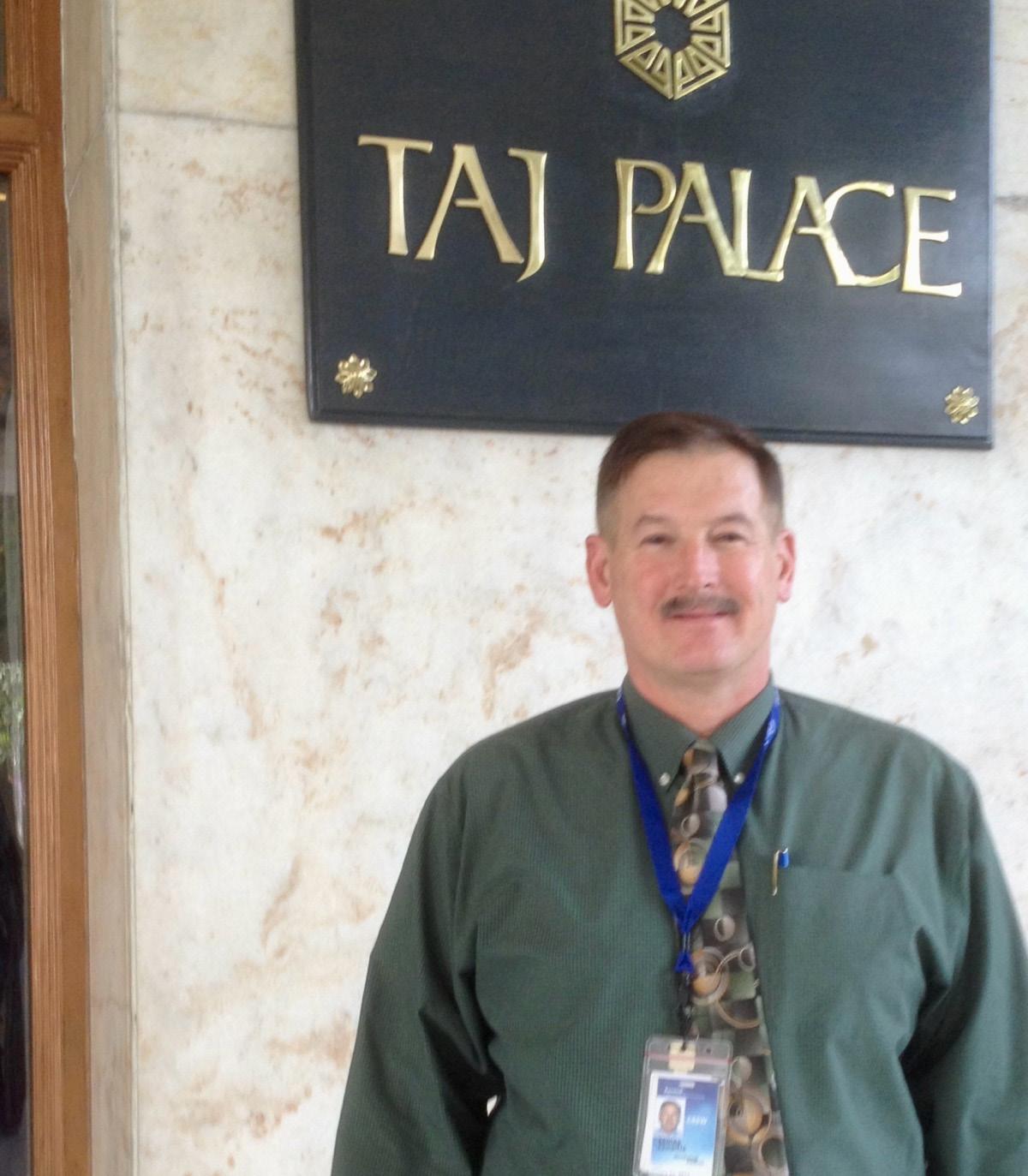
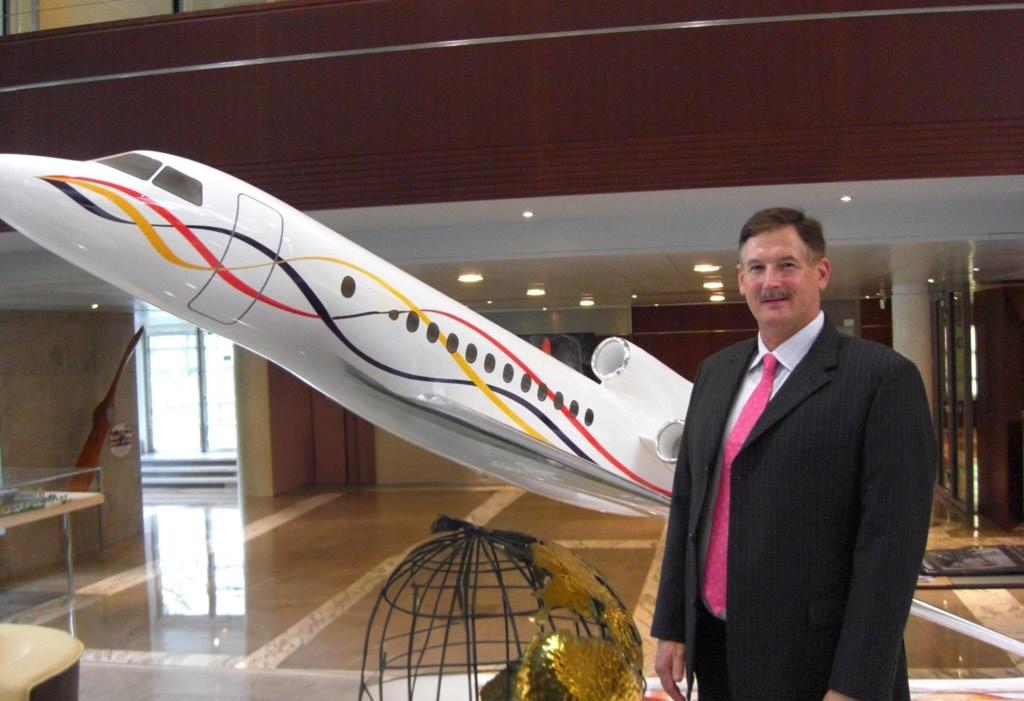
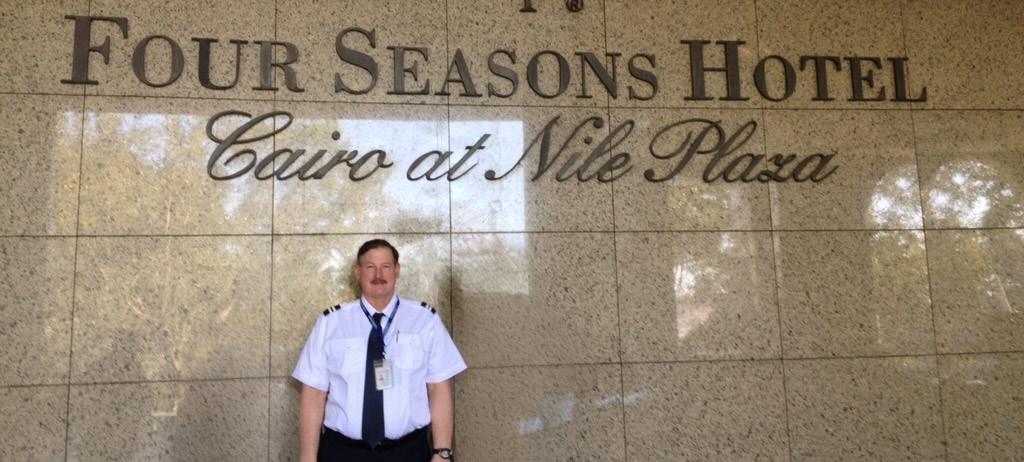
Continued from Page 12
valuable feedback that he integrated into AIM’s training modules.
Specifically, Bill Brown beefed up the AIM training program’s safety skills practices. He also introduced modules on test-taking and interview skills, which would directly benefit program graduates who planned to apply for real-world job opportunities. Finally, Brown formed the AIM advisory board, which meets monthly to act on airlines’ and students’ feedback.
This multifaceted guidance has spurred AIM’s owners to restructure the training facility’s operation. “Our owners are investing significantly into all of our campuses, not only in upgrading equipment and standards, but also curriculum and instructors,” Bill Brown emphasized. Together, these positive changes should position AIM’s graduates to be better equipped to excel in a complex employment market.
Student Dynamics Come Into Play
Jason Pfaff highlighted three additional factors that are helping to funnel students into AIM’s [and perhaps other schools’] aviation technician programs. First, he observed that a substantial percentage of students enter the aviation industry because of a family connection. “A brother, an uncle, a father or a mother—they’ve got someone [already] in the industry…What we talk about internally is there’s this ‘miracle of aviation’ that once you’re hooked, you’re captivated. A lot of folks get introduced to that very early in life.”
Next, Pfaff emphasized that the tide has begun to turn toward trade school programs. Specifically, a growing number of high school graduates are embracing hands-on careers with viable employment opportunities. This trend directly contrasts with a long-standing emphasis on a college education that may (or may not) generate related jobs “[In] this rising generation that’s graduating high school now, there’s a segment that’s like ‘the tool belt generation.’ They’re more interested and more predisposed to these types of mechanical careers than we saw over the last 10 to 15 to 20 years…As young adults pursue that path, I think aviation speaks to that population very well,” Jason Pfaff noted. Finally, existing workers seeking better career opportunities have also been gravitating toward aviation technician programs.
Together, these complementary recruitment dynamics can potentially change the aviation maintenance industry’s playing field. Although Jason Pfaff is decidedly optimistic about the industry’s long-term employment prospects, he recognized that worsening labor shortages will likely cause industry-wide challenges in the near term.
“If it’s a nine-inning game, I’d say we’re probably in the third inning…It will get more challenging. But again, from our perspective, at least from some of the conversations we’re having, this could also be a catalyst for a lot of really exciting change in our industry as well,” Jason Pfaff concluded.
https://www.flyingmag.com/report-business-jet-mar-ketcooling-but-still-strong/
https://www.arnolditkin.com/blog/injury/78-lives-lostexamining-the-surge-in-2025-plane-/
https://americanbazaaronline.com/2025/02/20/us-aviation-industry-struggling-amid-recent-plane-crashes-459789/
https://www.flyingmag.com/aviations-latest-labor-shortage/
https://www.naa.edu/what-does-an-aircraft-mechanic-do/
https://www.oliverwyman.com/our-expertise/insights/2025/feb/global-fleet-and-mro-market-forecast-2025-2035.html#:~:text=This%20year’s%20 Global %20Fleet%20And,CAGR)%20rate%20of%20 2.8%25
https://www.bls.gov/ooh/installation-maintenance-and-repair/aircraft-and-avionics-equipment-mechanics-and-technicians.htm
https://www.oliverwyman.com/our-expertise/insights/2017/dec/risk-journal-vol-7/rethinking-tactics/ not-enough-mechanics.html
https://www.faa.gov/mechanics/become
https://www.oliverwyman.com/content/dam/oli-verwyman/v2/publications/2017/dec/Not_Enough_ Mechanics.pdf
Personal SecurityDetail: Enjoythepeaceotmind thatcomeswithhavinghighlytrainedprotection specialistsb}'.you�side,nomatterwhereyoutravel.

